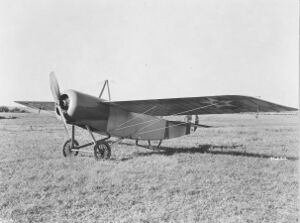Engineering:Albree Pigeon-Fraser Scout
| Albree Pigeon-Fraser | |
|---|---|

| |
| Role | Fighter |
| National origin | United States |
| Designer | George N. Albree |
| First flight | December 1917 |
| Status | cancelled |
| Number built | 3 |
The Albree Pigeon-Fraser was the first pursuit aircraft project for the United States Government.
Development
George Albree was awarded the first US pursuit aircraft contract in 1917. The aircraft was designed with a flat bottom airfoil and the aft fuselage was hinged to act like an elevator.[1]
Operational history
The first aircraft flew in December 1917, however it crashed on its first flight, killing the pilot.[2] The second aircraft never flew and was destroyed during structural testing. The third aircraft was not completed before the program was cancelled for being "too old-fashioned, unreliable, and slow".[1]
Survivor
The incomplete third aircraft was put into storage and in 1961 was acquired by the Old Rhinebeck Aerodrome where it is currently on display.[3]
Specifications
Data from The Complete Book of Fighters[4]
General characteristics
- Crew: 1
- Length: 24 ft 0 in (7.32 m)
- Wingspan: 37 ft 11 in (11.56 m)
- Gross weight: 1,250 lb (567 kg)
- Powerplant: 1 × Gnome rotary engine, 100 hp (75 kW)
Performance
- Maximum speed: 103 mph (166 km/h, 90 kn)
References
- ↑ 1.0 1.1 Holcomb, Kevin. "Albree Pigeon-Fraser Pursuit - Holcomb's Aerodrome". http://www.airminded.net/pigeon/pigeon.html.
- ↑ "Albree Pigeon Fraser | Aircraft in Focus" (in en-US). http://aircraft-in-focus.com/albree-pigeon-fraser/.
- ↑ "World War I (1914-1918) « Old Rhinebeck Aerodrome" (in en-US). http://oldrhinebeck.org/world-war-i/.
- ↑ Green & Swanborough 1994, p. 471
- Angelucci, Enzo; Bowers, Peter (1987). The American Fighter. Sparkford, UK: Haynes Publishing Group. ISBN 0-85429-635-2.
- Green, William; Swanborough, Gordon (1994). The Complete Book of Fighters. Smithmark Publishers. ISBN 0-8317-3939-8.

